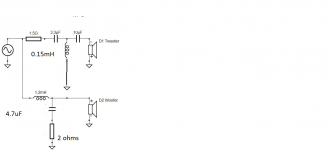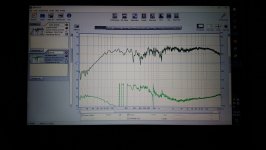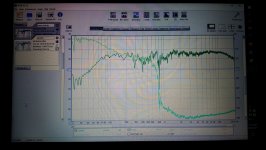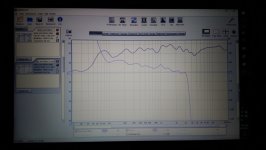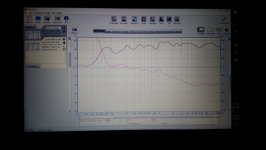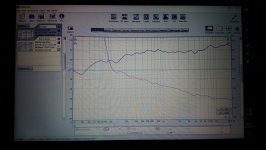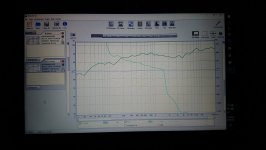Good morning everyone. I have modified the crossover of my BW DM602 based on what was published by Rutcho (mine are S1).
I have noticed an improvement for my ears since I noticed them with fatigued treble, I have noticed improvement in the scene and more defined bass.
All this with my ears since I do not have measuring instruments.
The original crossover is low pass first order and high pass third order. With tweeter in the same polarity as the woofer.
With the modification, the second order low pass remains, the high pass continues with the third order and the polarity of the tweeter reversed.
I have read the different degrees of phase shift that happens when we use first, second, third order crossovers, but I have not found what the phases look like when mixing low pass second order and high pass third order.
Although I find it nice how they sound now, I don't know if the modification of the phases hides or accentuates any range of frequencies.
Thanks a lo
This is the modification. Added a 1.5 ohm resistor, replaced 4.7uF in high pass by 3.3uF and added 4.7uf and a 2 ohms resistor in low pass. Tweeter inversion.
I have noticed an improvement for my ears since I noticed them with fatigued treble, I have noticed improvement in the scene and more defined bass.
All this with my ears since I do not have measuring instruments.
The original crossover is low pass first order and high pass third order. With tweeter in the same polarity as the woofer.
With the modification, the second order low pass remains, the high pass continues with the third order and the polarity of the tweeter reversed.
I have read the different degrees of phase shift that happens when we use first, second, third order crossovers, but I have not found what the phases look like when mixing low pass second order and high pass third order.
Although I find it nice how they sound now, I don't know if the modification of the phases hides or accentuates any range of frequencies.
Thanks a lo
This is the modification. Added a 1.5 ohm resistor, replaced 4.7uF in high pass by 3.3uF and added 4.7uf and a 2 ohms resistor in low pass. Tweeter inversion.
Attachments
Last edited:
There are other things that will change it. So you need to guess if you don't measure. Try it both ways.
If you have cell phone or laptop, you have measureing. Not perfect, but good enough for the task.
If you download a free spectrum analyser App for your phone, you can use the noise from an off-station FM tuner as a test signal. If the phase relationship between the drivers is wrong holding your phone at least a metre away on the axis of the tweeter you will see a deep suck-out at the crossover frequency. Use the phase with the smoothest transition at the crossover.
I am ignorant on the topic of crossovers.
I think my resistance to dabbling in them comes from repeatedly reading and hearing that "designing a good xover is not for everyone, it is a very complicated subject, it is the most important thing in an acoustic cabinet, etc.".
There were no computers in those years, ergo, no programs to calculate crossover networks.
So I don't have the slightest idea if these links can serve the OP.
Inverted-polarity
I think my resistance to dabbling in them comes from repeatedly reading and hearing that "designing a good xover is not for everyone, it is a very complicated subject, it is the most important thing in an acoustic cabinet, etc.".
There were no computers in those years, ergo, no programs to calculate crossover networks.
So I don't have the slightest idea if these links can serve the OP.
Inverted-polarity
Definitely try.
Crossovers aren't necessarily meant to have a deep suck-out when reversed. In some cases it isn't even clear which is better from this kind of before and after snapshot.
Crossovers aren't necessarily meant to have a deep suck-out when reversed. In some cases it isn't even clear which is better from this kind of before and after snapshot.
Allen is quite right. If there isn't a clear suck-out in cone connection compared to the other, it's a matter of choosing which connection sounds best. I would listen to noise and move your head around; sometimes one connection integrates better spatially than the other, but it really is system dependent.Crossovers aren't necessarily meant to have a deep suck-out when reversed. In some cases it isn't even clear which is better from this kind of before and after snapshot.
The microphone in a phone is good enough because you are making relative comparisons, not absolute measurements.
Holm Impulse is free and very simple. REW is free, little more complex, can provide more data, but you may not need that.
External calibrated mic is ideal, but even built in is enough to observe polarity.
Measure fr response in close proximity on axis, both ways, and wrong polarity will have dip. Correct polarity will be flat, if all is done right.
To measure is to know. All else is just theory.
External calibrated mic is ideal, but even built in is enough to observe polarity.
Measure fr response in close proximity on axis, both ways, and wrong polarity will have dip. Correct polarity will be flat, if all is done right.
To measure is to know. All else is just theory.
The description of the mod of a B&W DM601S3 is here: B&W Bowers Wilkins DM 601-S3 Crossover Upgrade for Better Midrange Perfoprmance
Service manuals of B&W speakers (including crossover description) can be found here: B&W Group North America Service & Support - Service Manuals
I see two problems in what the OP did. First, using a mod cleverly designed for the DM601S3 on the DM601S1. Those are different speakers, with different drivers and also crossover components. And in the lucky case that the drivers are so similar that work the same on the new crossover, at least the OP should have used the correct tweeter padding resistor (3R3 instead of 1R5).
The drivers polarity in a crossover depends on the ***acoustical*** slopes, and not on the electrical order of the crossover. I don't know what acoustical slopes are achieved in the mod, so I accept that the best summation is what I see in the page listed above. I said before that the mod is clever, as it uses the most parts of the original crossover, but I also bet that with different parts a better crossover can be achieved (the FR of the mod shows a not so good phase tracking for example at 2-3KHz).
Anyway, I would hope that drivers from different release are very similar, but without a calibrated mic, mandatory for crossover design, I would simply try the mod as is (with the correct padding resistor), and listen. If better than the original keep it, if not reverse to the original.
Ralf
Service manuals of B&W speakers (including crossover description) can be found here: B&W Group North America Service & Support - Service Manuals
I see two problems in what the OP did. First, using a mod cleverly designed for the DM601S3 on the DM601S1. Those are different speakers, with different drivers and also crossover components. And in the lucky case that the drivers are so similar that work the same on the new crossover, at least the OP should have used the correct tweeter padding resistor (3R3 instead of 1R5).
The drivers polarity in a crossover depends on the ***acoustical*** slopes, and not on the electrical order of the crossover. I don't know what acoustical slopes are achieved in the mod, so I accept that the best summation is what I see in the page listed above. I said before that the mod is clever, as it uses the most parts of the original crossover, but I also bet that with different parts a better crossover can be achieved (the FR of the mod shows a not so good phase tracking for example at 2-3KHz).
Anyway, I would hope that drivers from different release are very similar, but without a calibrated mic, mandatory for crossover design, I would simply try the mod as is (with the correct padding resistor), and listen. If better than the original keep it, if not reverse to the original.
Ralf
Except for bass, my MacBook laptop mic is barely different from my calibrated mic with both in the same location. And if you are working iteratively (for example, exploring EQ or XO), consistency matters, not accuracy.
Does anybody have a good excuse for not posting some REW measurements now?
Don't know how often I have tried polarity reversals with my large panel dipole panels and sub-woofers. Not usual for me to find one orientation decisively better than the opposite. Maybe drivers up close together in a box would be different.
B.
Does anybody have a good excuse for not posting some REW measurements now?
Don't know how often I have tried polarity reversals with my large panel dipole panels and sub-woofers. Not usual for me to find one orientation decisively better than the opposite. Maybe drivers up close together in a box would be different.
B.
Last edited:
here are three examples when I was designing some of my own speakers
I do not complicate things, I measure both polarities and decide
simple as that
people often ask what about 3-way or 4-way
no difference, just work on phase and polarity of tweeter and midrange, once done, move on to the midbass and top (mid/tweeter) and treat it as two speakers, then move on...
first example
I do not complicate things, I measure both polarities and decide
simple as that
people often ask what about 3-way or 4-way
no difference, just work on phase and polarity of tweeter and midrange, once done, move on to the midbass and top (mid/tweeter) and treat it as two speakers, then move on...
first example
Attachments
- Home
- Loudspeakers
- Multi-Way
- Tweeter polarity reversal or not
